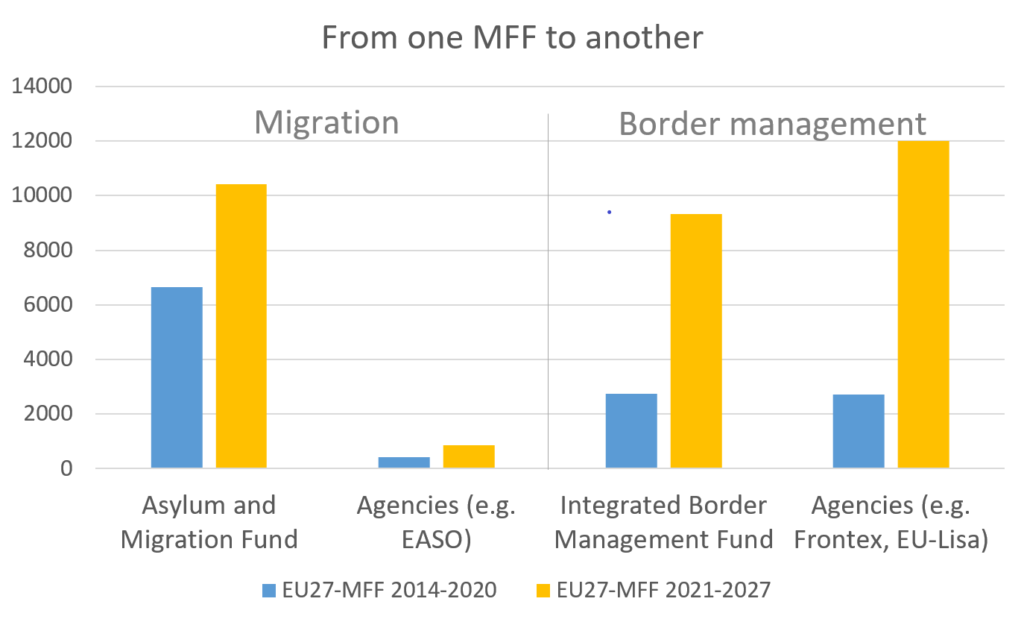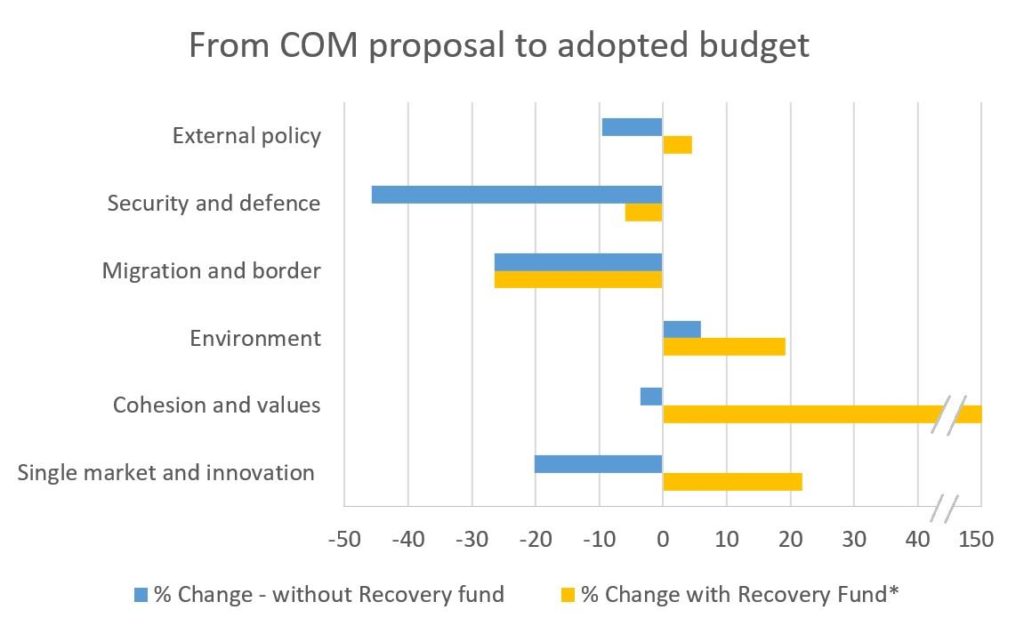By Pierre Van Wolleghem, Executive Scientific Coordinator of PROTECT
While the COVID-19 crisis is slowing down in Europe, EU member states have once again been called to decide on the priorities of the Union for the next seven years and agree on a massive recovery fund to mend the damages the pandemic has done to the EU’s economy. As Romanian Ministry of European Affairs, George Ciamba declared while his country held the rotating Presidency of the Council: “The European Budget is a reflection of how we see the European Union in the future”.
On 21 July 2020, after four days and nights of intense negotiations, EU leaders reached an agreement and announced the new Multiannual Financial Framework (MFF). As far as migration and border policy are concerned, the new MFF as agreed upon by the European Council looks little like the budget the Commission had in mind in the first place.
Initial proposal: Increased focus on border management
The Union’s migration policy has always constituted a small part of the common budget. It barely represented 0.93% of the total budget for the 2014-2020 MFF. For the 2021-2027 MFF, the Commission proposed a significant increase of the resources supporting the common immigration policy, which, considering the relative stability of the total Union budget (see factbox), translated in a decrease of the amount devoted to other policies. In total, had the Commission’s initial budget proposal been adopted, migration policy would have weighed about 2.73% of the total budget.
More precisely, the budget heading for migration and border policy would have increased from €10 billion for the period 2014-2020 to €31 billion for the period 2021-2027; that is, three times as much as with the previous MFF.
This increase would have regarded all the areas of the common immigration policy, although it would have been greater for border control and for the strengthening of the European Border and Coast Guard Agency.
While the allocation for migration and asylum was expected to increase by 39% compared to the 2014-2020 financial cycle, the resources allocated for border management would have increased by 243%.
Planning resources and facing the unforeseen
Planning the expense of the EU’s budget is striking a balance between predictability of spending, necessary to work on long-term objectives, and flexibility in order to face the unforeseen.
COVID-19 is not the first crisis the EU is facing; suffices to think of the economic and budgetary crises that hit the EU in 2008 and onwards or the so-called “refugee crisis” of 2014-2016. Those crises have shown how unforeseen events put pressure on states’ ability to collaborate and provide a joint response. The asylum crisis, notably with the failure to implement the two temporary relocation mechanisms adopted and the resort to the externalization of border controls with the EU-Turkey Statement, is a case in point.
That being stated, in the midst of the asylum crisis the funds for migration policy were topped up with significant resources to face the emergency – a 120% increase compared to the original budget.
These resources were used notably to finance the relocation agreements (which turned out to have limited effects), the creation of Hotspots to process entries and asylum applications, and reception facilities in Greece and Italy.
Factbox: the Multiannual Financial Framework (MFF)
- The MFF is the European Union’s long-term budget covering a period of seven years.
- Over the years, the EU budget has stabilized at around 1% of the member states’ cumulated Gross National Product (GNP) (for ease of reading, let’s call it EU-GNP).
- For example, it represented 1.25% of EU-GNP in the period 1993-1999 and 1% in the 2014-2020 period.
- According to the Commission proposal for the MFF 2021-2027, put forth in May 2018, it would represent 1.11% of EU-GNP.
- The adopted version of the budget amounts to 1% of EU-GNP.
Migration and Border policies in the 2014-2020 MFF and in the proposal for a 2021-2027 MFF (€ million, current prices)

The figures used are in constant 2018 prices and are based on the European Parliament’s estimates.
Flexibility in spending EU money has been an objective since the first funds for migration were put in place (2007-2013 MFF) and, from one MFF to another, the Union’s expenditure on migration policy has become more flexible.
See the article ‘Where is the EU’s Migrant Integration Policy Heading? A Neofunctionalist Take on Three Multiannual Financial Fraweworks’ for more on this.
In the wake of the asylum crisis, the next MFF foresees the creation of a Thematic Facility, a new envelop within the Asylum and Migration Fund, that represents 40% of the fund’s total amount; that is, about €4.2 billion (in current prices). “What’s a Thematic Facility?” one would ask. The term appears to be new (or at least it is for migration funds). ); it is a part of the fund that is aimed to implement the EU’s priorities (as opposed to national ones) as defined by Commission decisions
Also read: Migrants and integration: what the European Union can do
More specifically, these regard Union actions, emergency assistance, support for solidarity measures inter alia. For the same type of activities, the previous MFF allocated some 14% of the total. In a nutshell, the introduction of a large Thematic Facility heralds a change in the way the EU’s migration policy is going to be financed: less money to be spent at the member states’ discretion and more money to be spent for common objectives potential future crises.
…and then COVID-19 happened
The COVID-19 crisis and the ensuing economic crisis, the effects of which are now clearly visible and are set to last, have called for solidarity among member states to support the countries the most affected. The Commission has put forth a proposal to boost economic recovery through a €750 billion fund that addresses immediate challenges. Interestingly, this fund will not be financed on the EU’s own resource (that is, the EU’s budget) but through the emission of bonds on financial markets. However, in order to tackle the economic objectives, the Commission also proposed to amend its proposal for the next MFF in order to reinforce the EU’s economy in the longer run.
Considering the second MFF proposal together with the resources brought about by the Recovery Fund, the biggest winner appeared to be the cohesion policy with a 151% increase compared to the first MFF proposal, followed by the single market, innovation, and digital policy, with a 27% increase.
In the face of the current emergency, one could have expected cuts in migration-related policies, too. Yet, the new Commission proposal actually increased the funds for migration – by 21% – whilst it decreased the funds for border management – by 6%. However, the budget as agreed by the European Council confirmed our expectations.
The adoption of the new MFF and the Recovery fund
The figures advanced by the Commission in its proposals is one thing; the actual budget adopted by the unanimity of the member states is another. After four days and four nights of intense negotiations, the EU leaders finally reached an agreement on July the 21st. The deal announced budget cuts across the board as far as the MFF is concerned. The final figures are however supplemented with the Recovery Fund (remember that the MFF is financed by member states’ contribution whilst the Recovery Fund is financed by capitals raised on financial markets). The cuts are particularly drastic for the heading “migration and border management”, as it is not concerned with the Recovery Fund: instead of the €31 billion foreseen in the Commission’s proposal, the appropriation for commitments in the adopted budget plans a maximum of €22.7 billion; that is, a 26.5% decrease (which is still a significant increase with respect to the 2014-2020 MFF). The Asylum and Migration Fund is decreased by 16.4% (and now amount to €8.7 billion) whilst the funds for border management are halved (now amounting to €10.7 billion).
As far as migration and border policy is concerned, the new MFF as agreed upon by the European Council looks little like what the Commission had in mind in the first place. Elaborated in the wake of the asylum crisis, the Commission’s proposal placed much emphasis on border control. One may recall ex-Budget Commissioner Oettinger’s intention to hire 10,000 border guards for the Frontex agency. Two years after, the deal reached by the EU leaders seems to put such emphasis into question. That being said, only a careful analysis of the budget’s implementing acts; decisions and regulations, will help us understand where the EU’s migration and border policy is headed.
Budget changes between the Commission’s first proposal and adopted budget, with and without the Recovery Fund (%)

Source: own elaboration from Commission proposal and European Council’s Conclusions. The figures considered for calculation are in 2018 prices. *: own estimation based on Commission proposal.
